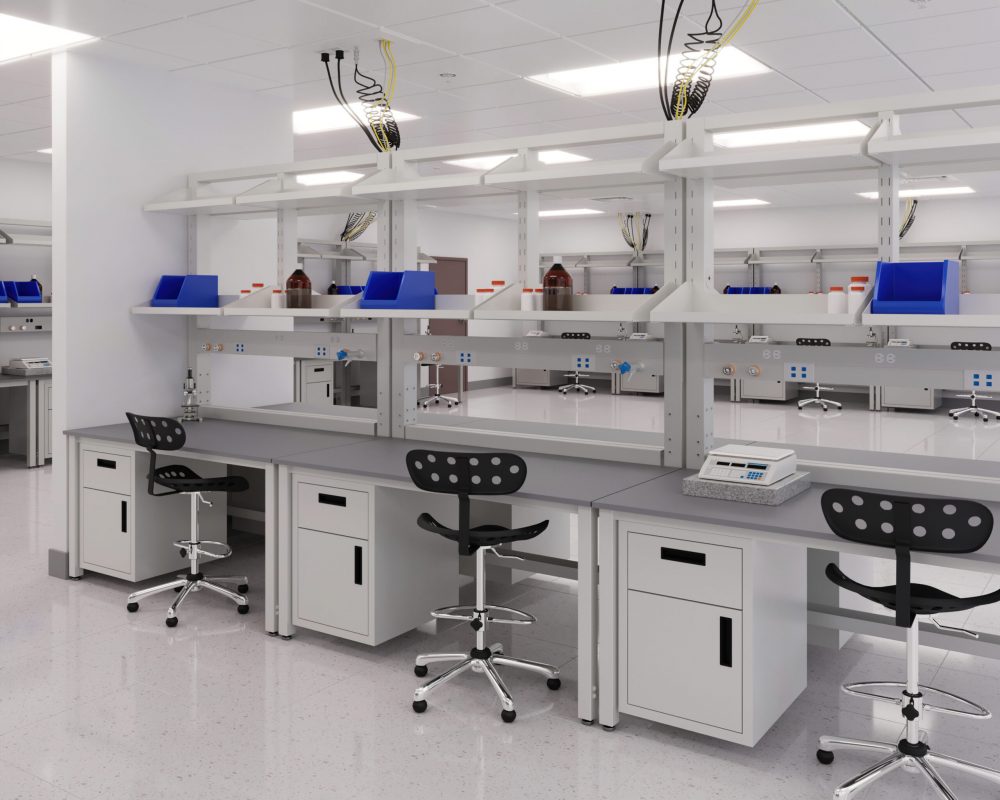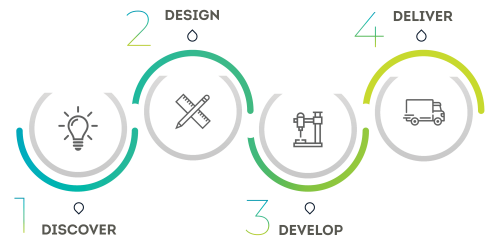WDM connected with Brett Gray, Product Manager and Industrial Team Lead at Formaspace, to learn more about how their products make it simple for architects, designers, and facility planning professionals entering the lab design market.
WDM: Can you give us some insight on current work trends in the biotech, pharma, and healthcare space? How has it changed since the pandemic?

Brett: In our experience, one factor that has stood out in biotech overall is continued strong growth – both during and after the pandemic.
A lot of money is going into new biotechnology enterprises. We believe this new investment is inspired by the success of recent innovations, such as the very successful mRNA vaccines.
Another key point I should add is that during the pandemic, laboratory research, particularly in so-called “wet labs,” continued to be largely an ‘in-person’ activity. Unlike office professionals, you can’t easily set up a home office laboratory to conduct experiments.
WDM: How have these trends influenced your laboratory furniture offerings?
Brett: One thing we’ve noticed is that this growth is not distributed equally across the country. Biotech research labs tend to be concentrated in key markets, the so-called biotech hubs, with Boston, the greater NYC region, San Francisco, and San Diego being the strongest markets.
These regions have expensive real estate, and rents for laboratory facilities have remained high, even before the onset of the pandemic.
As a result, we’re seeing a lot of buildings being converted over to laboratory use. Many facilities are also remodeling with efficiency in mind, trying to increase productivity within the existing floor plate (to avoid leasing more expensive space.)
These trends have influenced our product offerings.
One of our primary goals is to make it easier to convert existing spaces (such as former warehouses or even shopping malls) into lab facilities – or redesign existing spaces.
In doing this, we want to “maintain a light footprint on the floor plate.”
We try to accomplish this by creating lab furniture products that have built-in infrastructure components.

Take our new award-winning FLX line, for example; it’s a modular solution that makes installations easier. For example, you can drop all the utility services found in a lab (water, electric, gases) from either overhead service pales or bring them up from the floor.
Customers also love to specify the FLX modules in a back-to-back configuration; here it serves double duty as a space divider.
WDM: How is this modular approach different from traditional laboratories? I’m thinking of old-school lab installations from school.
Brett: Well, many customers do want the “old school” laboratory look and feel, for example, school laboratories with the classic black phenolic resin worksurface you might remember from school. Other clients want to expand an existing laboratory with a design that matches the look and feel of their existing traditional casework (e.g. built-in) designs. Because we are a custom manufacturer, we can match an existing design if you want to expand or recreate the traditional look. Everything is custom, we can build it in stainless steel or hardwood, whatever the customer wants.

But for many customers, the guiding principle for new laboratory construction or remodeling is to try to “future-proof” the installation, and that is where modular designs shine.
Many customers are realizing that science is changing too quickly to get locked into a design layout permanently. Projects are not forever. Leases are not forever. Equipment is not forever.
Modular designs address this. They can be installed with hand tools and then taken apart and reconfigured everything as your needs change. You can also pack them up when your lease ends, or you are asked to move to another facility – then reinstall them in the new location. Mobile workstations and desks mounted on casters are even easier to reconfigure. You just roll them into new layouts as needs change.
And because we are the original equipment manufacturer, we can supply you with matching furniture components at any time if you want to add another lab bench or sink station, or even supply all the kit needed to build out a new matching lab space.
Our customers that are keen on improving sustainability really like this aspect of modular design. You can recycle and upcycle the installations and even qualify for LEED credits when you move the modular components to a new location.

WDM: Very interesting. It’s good to know about the sustainability factor. Can you name any other current lab design work trends?
Brett: Sure. Two things come to mind immediately.
First, there is a new emphasis on using big data, machine learning, and artificial intelligence in biotech science. These techniques can help identify promising new drug compounds or help identify the underlying cause of disease.
As a result, the mix of so-called dry labs, which include computer science and data analysis facilities, is growing, taking a larger share compared to traditional wet labs, which handle physical specimens and wet chemicals.
The second trend is a renewed emphasis on promoting collaboration; it’s the holy grail in science. To accomplish this, facility planners, architects, and designers are looking at ways to create more spontaneous encounters and impromptu meetings.
On a small scale, this means adding more shared facilities, such as conference areas, lounge and study areas, libraries, and on-site cafeterias to encourage people to meet and break down the silos that tend to exist between departments.
At the large scale, fully integrated science parks are seeing a resurgence, particularly across Asia; these often feature a rich, one-stop-shop assortment of amenities that encourage researchers to work together.
WDM: Many of our readers are Architects and Designers who are very interested in breaking into the lab design market. Do you have any advice for them?
Brett: This is an important topic at Formaspace.
As a custom manufacturer, we not only build standard lab items, like workbenches, but also fully custom installations.
We welcome working with architects, designers, lab managers, facility planners, and furniture professionals who specify furniture purchases.
Formaspace understands that lab projects can be intimidating
But let’s look at the inventory of skills that architects and designers (A+D) and other professionals have in their pockets.

Here are just some of the things that A+D / furniture professionals bring to the table:
- An understanding of how to build an attractive space where you want to come to work
- Creating productive environments that encourage impromptu collaboration
- Establishing good functional flow within a workspace
- Knowledge of how to use light and spatial to create an open, welcoming workplace
- Respect for employees and the environment, including sustainability
And another point in their favor is that, as we pointed out earlier, more and more lab work is transitioning into data analysis with a strong collaboration component – this translates into creating spaces that support these activities, such as common cafeteria spaces, libraries, quiet spaces, informal meeting areas – in other words, spaces that commercial architects and designers will have the necessary expertise.
WDM: That’s a really good point, especially with the growth of data-driven science. But what about wet labs and other types of labs with what we might call more “intimidating” requirements?
Brett: It’s true, many laboratory designs do require the involvement of experts, particularly in the case of wet labs or laboratories in specialized fields, such as clinical testing, pharma or food manufacturing, chip-making facilities, or bio labs where pathogens are investigated.
Many of these labs will be governed by rigorous safety and operational protocols – ranging from GMP for pharma and food products, animal handling protocols, cleanroom operations, bio-safety labs, explosives and gas storage, contamination control, and safety and hygiene protocols.
In these cases, experts with specific lab design and regulatory compliance expertise and responsibility are brought in on the project, either from the client’s team or hired as an outside consultant.
The architects and designs can work with the expert (or team of experts) who will take the lead in key areas, including the design of safe airflow (including HVAC or cleanroom systems), utilities, noise control, equipment specification (including fume hoods and snorkels), as well as specifying chemically resistant materials.
WDM: This still sounds complex. What role does Formaspace play in facilitating these projects?
Brett: Our role depends on the specific client and the team they have assembled.
For example, with larger clients that have long-established expertise on board, our role is more of a team member. In these instances, we serve as a proactive custom furniture manufacturer who can work directly with the client’s representatives to explore specific design options, including equipment specifications, material selections, etc. as well assisting the regulatory compliance team in meeting any specific requirements governing the project.

We then take that plan and execute the laboratory furniture build-out at our factory headquarters in Austin, Texas. In some cases, we travel to the site to perform the final installation. In other cases, we hand that off to the client as they wish.
For smaller-scale projects (at a school or university, for example), Formaspace can help advise the client on how to establish a productive oversight team. In these cases, we sometimes perform a dual role of assisting as a lab design and facility planning consultant as well as our role as a manufacturer.
WDM: This sounds very promising. How can our readers make contact with Formaspace for their next laboratory project?
Brett: Thanks for the opportunity to speak with you today.
As we like to say, if you can imagine it, we can build it, here at our Austin, Texas, factory headquarters.
We encourage your readers to get in touch with our local representatives – they are eager to share their long-standing expertise and help make your next project a success.
Also, important to note for government, military, and educational customers: Formaspace furniture is available through Federal GSA contracts as well as TIPS (The Interlocal Purchasing System) Purchasing Cooperative.
This article was written in partnership with:



